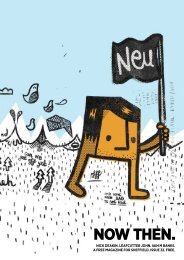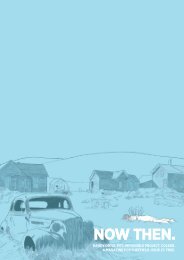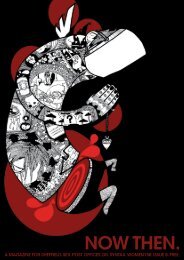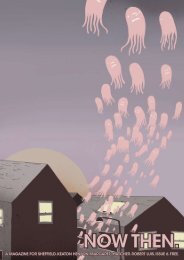You also want an ePaper? Increase the reach of your titles
YUMPU automatically turns print PDFs into web optimized ePapers that Google loves.
Technology is not really my thing.<br />
Getting to grips with it quickly does not<br />
come particularly naturally to me. This is<br />
a pity because it features rather heavily in<br />
my subject - Broadcast Journalism. And<br />
technology is playing an increasingly<br />
important role for reporters.<br />
Where there used to be television reporters there are now<br />
multi-skilled ‘video-journalists’ – people who no longer work<br />
in small teams, but who are expected to do the reporting,<br />
filming and editing on their own. The main reason for this<br />
development, of course, is financial. It is cheaper to get<br />
one person to do the whole lot than pay expensive crews<br />
for their time. But who knows, reporters having to do three<br />
jobs rolled into one on a day to day basis may simply lead<br />
to burn-out. Quality of television news output may suffer<br />
(some would say it already has) and ultimately television<br />
executives may be forced to go full circle and re-employ all<br />
those cameramen and editors they laid off.<br />
New technology is everywhere. And it seems to come<br />
so naturally to young people. The younger they are the<br />
more affinity they seem to have with all things technical.<br />
My six year old daughter Nikki knows more about how<br />
to use my computer, mobile phone and iPod than I do!<br />
But, despite my rather difficult personal relationship with<br />
new technology, I absolutely believe that it should be<br />
embraced. It has an increasingly crucial place in Higher<br />
Education teaching which cannot and must not be ignored<br />
by academics. Here’s an example of how new technology<br />
has helped improve one of my courses.<br />
My students have to learn how to use a particular radio<br />
computer programme to write news scripts, embed audio<br />
and compile radio news bulletins. The programme is called<br />
Burli. It is not complicated (even I managed to master it<br />
pretty quickly) but there is a fair amount to take in if you<br />
have not used a newsroom computer system before.<br />
Having to teach this programme to around 60 students,<br />
split into five groups of 12 for workshops, became a<br />
nightmare situation. Only three workshops out of the 12<br />
teaching weeks could be dedicated to learning Burli, but<br />
the students were also expected to learn how to adapt their<br />
writing for radio, record their voice, edit their material and<br />
use different types of radio news formats during their three<br />
sessions. It was a serious challenge. The students inevitably<br />
worked at varying paces. I would try to go round and talk<br />
to each person as they worked, but it was time consuming.<br />
Having to repeat this procedure five times over with the five<br />
different workshop groups felt like a very unsatisfactory use<br />
of time, both for me and for the students. A solution was<br />
needed – and fast!! What I did was to work with a colleague<br />
to come up with an online tutorial in Burli which used a type<br />
of screencast. My colleague recorded her voice giving<br />
step by step instructions, while an interactive screen would<br />
show the mouse arrow clicking on various icons in Burli to<br />
demonstrate. It was ingenious, and also very efficient on<br />
time. I now have a new system. I ask the students to prepare<br />
for each workshop session by following the relevant online<br />
Burli tutorial which can be found on our Journalism Studies<br />
intranet. It has worked wonders. They do it, they understand<br />
it, and they arrive at the workshop sessions with a basic<br />
knowledge of the programme. This enables me to dedicate<br />
the precious time we have to teaching radio journalism,<br />
rather than which buttons to press. The sessions are less<br />
pressured and students can work on exercises in their own<br />
time while getting one to one feedback from me.<br />
New technology does have to be used carefully<br />
though. PowerPoint is a good example of a technological<br />
development which can add so much to lectures when<br />
used well, but is also often abused and used very badly.<br />
Students sometimes complain that all a lecturer does is<br />
repeat what is on the slide in front of them, and in this case<br />
it is easy to see why they may prefer to simply have the<br />
notes rather than go to the lecture. I have seen lecturers<br />
‘hide’ behind their PP displays in a way that puts them<br />
into the background and their fancy slides in the forefront.<br />
The lectures which seem to have the most impact on<br />
students are those where the lecturer finds a way to interact<br />
with them, engage them, and it often has nothing to do<br />
with whether they use PP or not. <strong>In</strong> fact, students have<br />
sometimes said they find it refreshing when there is no PP<br />
used!<br />
There is no doubt that e-learning opens up access to<br />
educational opportunities to an amazing degree, but<br />
developments such as putting lecture notes up on the<br />
internet is controversial and I can understand why some<br />
academics (some of my colleagues included) are reluctant<br />
to do this. As well as copyright issues there is the worry that<br />
students will feel there is no point in attending lectures as<br />
the information is readily available. This could be seen as<br />
posing a threat to the role of a lecturer and raises questions<br />
over the purpose of teaching itself.<br />
But I do not go along with this. By allowing our lecture<br />
notes to be ‘open to all’ we are simply allowing information<br />
to be transmitted. This is only part of understanding.<br />
Understanding itself cannot be transmitted. A big part of<br />
learning is about dialogue and interaction between student<br />
and teacher. This is why, in my experience, workshop<br />
teaching in small groups is so much more effective than the<br />
traditional ‘lecture’.<br />
A colleague based in the English Literature department<br />
told me something rather interesting. A blog had been set<br />
up for his students encouraging them to write their response<br />
to certain pieces of literature. They produced some<br />
impressive writing on the web. The students were creative,<br />
free-flowing and wrote incredibly well. When asked to do<br />
something similar in the form of an essay the standard of<br />
writing went right down. The essay-writing was dry, turgid<br />
and boring!! Analyse that as you will….<br />
New technology should be tried, tested and<br />
experimented with. We, as educators, should be openminded<br />
about absolutely anything that may enhance<br />
student learning. However, judgements should be made<br />
and the fundamentals of teaching should not be forgotten.<br />
<strong>In</strong> my experience, you cannot beat face to face teaching –<br />
particularly one-to-one time with students.<br />
<strong>Now</strong>, Nikki, how do you work this DVD player?!<br />
KATIE STEWART.<br />
NEW TECHNOLOGY.<br />
BRAVE NEW WORLD.<br />
PAGe thirty-nine.












